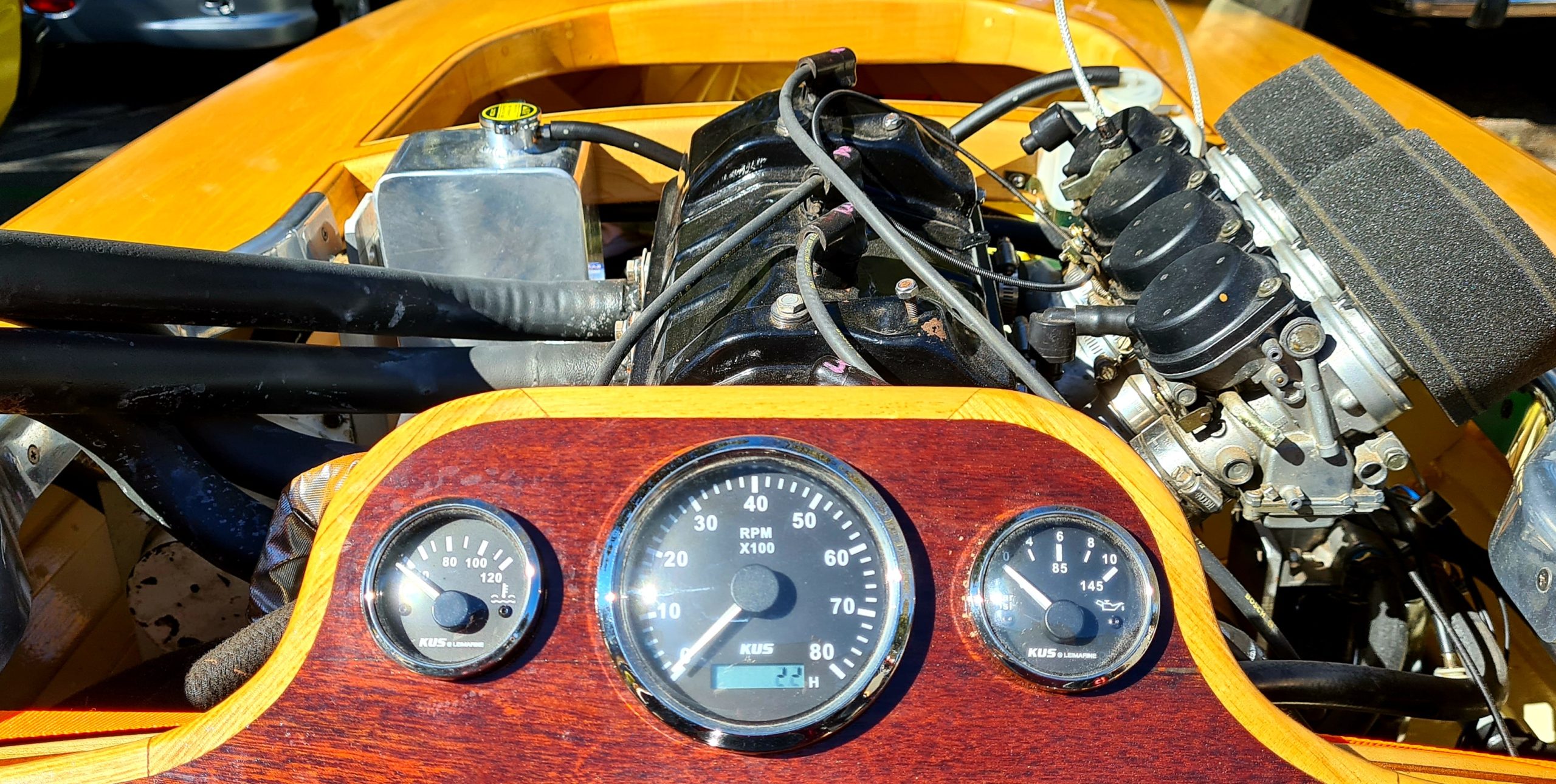June, 1993. By Garry Gascoigne, with an introduction by the Editor
Our club treasurer Ray owns a history-packed Peugeot-powered racing skiff called Cindy, as most club members know. Cindy’s not alone. Ray has two more Peugeot-powered mystery craft stashed away in his shed, and he’s promised to show a little more of those over the coming months.
CINDY 1961 1976
Cindy was originally powered by an Austin 1500 cc 4cyl engine similar to MGB
power plant. The limitations of this engine soon became apparent, (overall weight
and cylinder head design etc), and in 1964 was changed to a modified Peugeot
203 engine with over bored sleeves, and later with a strengthened 403 engine
block.
The Peugeot developed excellent power and torque, but did have some inherent
weaknesses which came to light as the engine power was increased, and even
though modifications helped considerably, the Peugeot engine block in hindsight
was really too lightly constructed for the power that was developed.
This engine powered Cindy for most of her racing life only replaced briefly by a
Peugeot 404 in 1973, and then by an experimental Ford 4 cylinder 1500cc
crossflow engine, while not having the top speed of the original Peugeot, its
reliability was far superior, born out by the fact that it completed five grueling
championships on one weekend.
Incidentally the Peugeot 403 was fitted initially to The Hydroplane Titan, and ran
as high as 8000 RPM, but again reliability was a problem.
Cindy has been refitted with the original Peugeot engine as she was when at her
peak representing Western Australia at Lake Bullen Merri, Camperdown
Victoria in 1965 coming second, and winning the Australian 95 cubic inch
championship in 1966.
Cindy was one of the fastest 95 cubic inch Skiffs in Australia, and also was very
competitive with boats of larger engine capacity winning the Mandurah Own
Cola Champion of Champions in 1967.
Cindy finished racing at the end of the 1976 season when she competed in four
Australian Championships, two or which were 100 cubic inch capacity, the other
two 155 and 225 cubic inch, finishing with three second and one third place. At
the end of her career she was still one of the fastest 95 cubic inch piston engine
powered skiffs in Australia, being beaten only by the controversial Mazda Rotary
Engine.
The driving honors were dune mostly by Garry Gascoigne, however she was also
driven by his father Harold, as some times both Cindy and Titan were competing
against each other in the same race. The mechanical work was a team effort with
Harold’s Motor Cycle Racing experience having a big bearing on the engine
modifications.
Cindy
DONOR: The Gascoigne Family
HULL TYPE: Skiff (displacement hull)
BUILT: 1961
BUILDER: George Brewer.
MATERIAL: Oregon and marine ply
FASTENERS: Copper rivets and epoxy glue
ENGINE: Based on 403 Peugeot wet sleeve engine
CAPACITY: 95 Cubic inch ( 1560cc )
COMPRESSION RATIO: 11.5:1
FUEL: 100 octane , Vacuum No 2 racing fuel
CAMSHAFT: Bill Kirkham.
VALVE TIMING: Inlet opens 45 degrees before TDC:’
Inlet closes 65 degrees after MC
Exhaust opens 65 degrees before BDC
Exhaust closes 45 degrees after TDC
Valve lift – 7/16 of an inch
PISTONS: Raised crown high compression.
CYLINDER HEAD: Aluminium hemispherical, cross-flow.
INLET PORT: 1.5 inches.
EXHAUST PORT: 1.25 inches
CARBURETTORS: 4 x Amal Monoblocks
CYLINDER BLOCK: Gascoigne modified 403 Peugeot.
MAX RPM: 6500 rpm
PUMP: Aircraft dual pump cam shaft driven.
LUBRICATION TYPE: Dry sump.
PRESSURE: 80 psi
SPARK PLUGS: 10mm KLG T260 racing plugs.
PROPELLOR: 9 inch diam. x 14 inch pitch.
PROP SHAFT: 3/4 inch diam. SD50 steel.
MAXIMUM SPEED: 66 mph (110 kmh)




